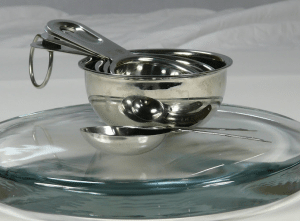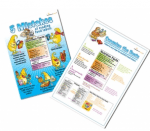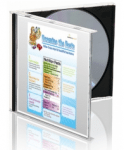Three Steps for Deciphering a Nutrition Facts Label
Section 1 - Build Calorie and Portion Awareness.
- Serving size - How big is this serving, given the number of calories it contains? Remember, MyPlate advises people to avoid oversized portions.
- Servings per container - Are there really 3 servings in that single giant bar of chocolate? Make sure you know how many calories you are really eating!
- Calories per serving - Find out how many calories you need per day in order to maintain your current body weight (pounds):
 For sedentary people:Weight x 14 = estimated calories per day; this is about 2000 calories for someone 145 pounds.For moderately active people:Weight x 16 = estimated calories per dayFor more active people:Weight x 17 = estimated calories per day
For sedentary people:Weight x 14 = estimated calories per day; this is about 2000 calories for someone 145 pounds.For moderately active people:Weight x 16 = estimated calories per dayFor more active people:Weight x 17 = estimated calories per day
Section 2 - Beware of Heart Stoppers!
- Check the % Daily Value – 5% or less is low and 20% or more is high.
- Fat - Keep total fat intake between 20 to 35 percent of calories, with most fats coming from fish, nuts, and vegetable oils.
- Saturated fat - This fat increases bad cholesterol, which can lead to buildup in your arteries. Limit saturated fat consumption to 10% or less of your calorie intake. That's about 16 grams (or less!) per day for most people.
- Trans fat - This fat is found mostly in processed foods that contain partially hydrogenated oils. It has been shown to increase bad cholesterol and reduce good cholesterol. It spells trouble for your heart. Most health authorities set the upper limit for this fat at 0 calories per day or less than 1% of your diet.
- Cholesterol is only in products from animals. so think meat and dairy products. It has also been shown to raise bad cholesterol. Keep your cholesterol consumption to 300 mg or less per day.
- Sodium is found in really high amounts amounts in processed and prepared foods. Excess sodium in the diet leads to high blood pressure and other health problems.
Section 3 - Get the Good Stuff.
- The Dietary Guidelines for Americans has declared dietary fiber a "nutrient of concern," which means that most people simply don't eat enough of it. Dietary fiber aids weight loss, helps lower cholesterol, helps control blood sugar, and keeps our digestive tracts on the move. Aim for 14 grams per day for every 1,000 calories you consume. Increase your fiber intake slowly and drink plenty of water when you do.
- Vitamins and minerals listed on the food label help us decide whether a product contains important nutrients. Follow the tips and instructions at choosemyplate.gov to ensure that you are getting adequate nutrients and enough variety in your diet.
Examine the Facts
- Count calories
- Check cholesterol, sodium, and fat stats -- Is this product good for your heart?
- Consider vitamin and mineral info-- Is this food nutritionally valuable?
Use the three step approach on the Nutrition Facts panel below. What do you see? Is this a food that is good for you?

Brought to you by: TheNutritionEducationStore.com. Check out our Nutrition Facts label category for posters, PowerPoint Shows, games, and handouts that review strategies for interpreting Nutrition Facts, nutrient-finding tips, and much more!

